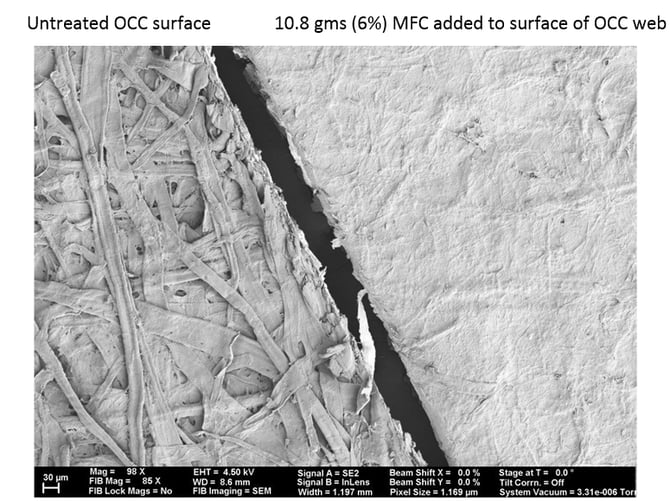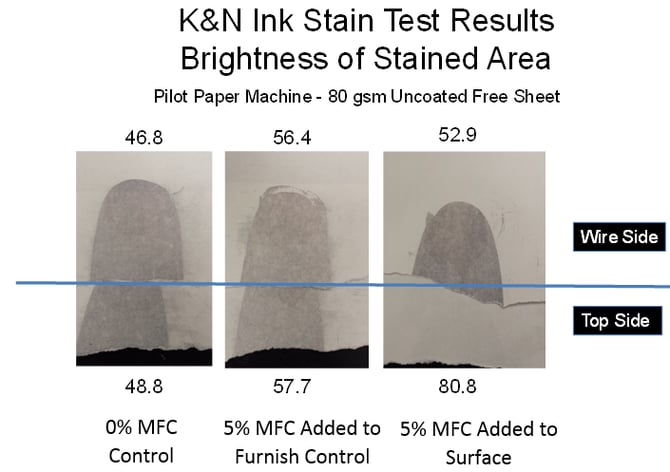
Improved paper surface properties by microfibrillated cellulose
Michael Bilodeau | September 6, 2016
Among the many potential applications of cellulosic nanomaterials, one of the most promising is the use of microfibrillated cellulose (MFC) to enhance the surface of paper products. The vast majority of paper products, from cardstock to fast-food packaging, receive some type of functional coating during manufacturing to improve end-use performance. Coatings can impart many different properties to paper products, including water, oil and grease resistance, reproduction quality, absorbency and smoothness. Many different materials are used to coat paper surfaces ranging from minerals, natural and synthetic binders, and polymers.
Opportunities in paper coatings
The use of microfibrillated cellulose as a coating component offers many benefits for the production of both new and conventional paper grades. Cellulose fibrils are unusually light, strong and absorbent, making them an excellent candidate as an ingredient in paper coatings. In addition to its strength and flexibility, MFC is a renewable and sustainable material with a low environmental impact. Microfibrillated cellulose can now be manufactured in industrial quantities at relatively low cost. All of these qualities make MFC an attractive option for high volume pulp and paper applications.
→ Read also: What is microfibrillated cellulose (MFC?)
The University of Maine’s Process Development Center (PDC) and GL&V, a leading global pulp and paper equipment supplier, have formed an alliance to commercialize FibreFineTM technology to cost effectively produce MFC. In addition, the PDC and GL&V have recently been developing a technology to apply MFC to the surface of a forming web. This technology leverages GL&V’s HydroSizerTM technology, which is currently used to apply uncooked starch on board grades. This HydroSizerTM speciality applicator allows a precise, thin layer of MFC slurry to be applied to a still-forming sheet surface (for more information, visit PDC’s homepage).
Surface application of MFC successfully tested in a pilot trial
The results of early pilot trials have been very encouraging. Multiple paper grades have been produced during a series of pilot trials, including an OCC (old corrugated container) packaging grade consisting of low-cost recycled fiber.
The paper that had been treated with MFC as a thin coating layer demonstrated greater wet and dry strength, enhanced surface characteristics, and improved barrier properties compared to the untreated control papers. The results from the OCC packaging grade were particularly encouraging. Surface application of the MFC resulted in dramatically improved fiber coverage, reduced air porosity, and improved surface smoothness. The surface application of MFC overcomes drainage issues sometimes observed with similar loadings of MFC added directly to the furnish. Figure 1 shows the application of MFC to the surface of an OCC web compared to internal loading of MFC.
 Figure 1 – Surface application of MFC (on the picture microfibrillated cellulose, MFC) on OCC packaging grade (source of the picture: University of Maine).
Figure 1 – Surface application of MFC (on the picture microfibrillated cellulose, MFC) on OCC packaging grade (source of the picture: University of Maine).
Figure 2 shows the impact of surface applied MFC compared to internally loaded MFC in uncoated offset papers.

Figure 2 – Surface Uniformity of Surface Applied and Internal Application of MFC in Uncoated Offset Paper (Source of the picture: University of Maine).
We have still only scratched the surface of the potential applications of microfibrillated cellulose, and the use of MFC to enhance the surface of paper products is another exciting development in this emergent field. As the benefits of utilizing microfibrillated cellulose are demonstrated in an increasing number of applications, the demand for this material will only grow.
Written by:
Michael Bilodeau
